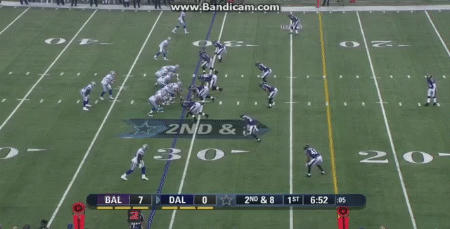I don't know what case play you're talking about, but the 2014 play that most resembles Dez's play is A.R. 15.95, and it doesn't have one word about regaining balance. Here it is in its entirety:
2014
A.R. 15.95
Act common to game
Third-&-10 on A20. Pass over the middle is ruled incomplete at the A30. The receiver controlled the pass with one foot down and was then contacted by a defender. As he went to the ground, he got his 2nd foot down and then still in control of the ball he lunged for the line to gain, losing the ball when he landed.
Ruling: Reviewable. Completed pass. A’s ball first-and-10 on A30.
In this situation, the act of lunging is not part of the process of the catch. He has completed the time element required for the pass to be complete and does not have to hold onto the ball when he hits the ground. When he hit the ground, he was down by contact.
It does
not say the act of lunging didn't
complete the process of the catch. It says the act of lunging is not
part of the process of the catch, which it isn't. It's the act that shows that the player has satisfied the time requirement after control and two feet. Clearly the "act of lunging" is the "act common to the game" to which the heading refers. There is nothing about the act of "regaining balance." Those words are 100% yours, my friend.
Acts common to the game weren't ALL spelled out in the rules in 2014, and still aren't.
Reaching for the goal line and
lunging were both acts common to the game in 2014, and you can follow those links to videos in which Blandino says so. "Taking additional steps" was added in 2016, although there's no reason to assume that wasn't a football move in 2014. An act common to the game completed the catch process in 2014. A player who had completed the catch process didn't have to control the ball when he hit the ground in 2014. That's why Blandino had to say he looked for an
act common to the game here, and
here, and
here.
It's for players who go to the ground in the process of catching a pass, as opposed to players who complete the catch process before they go to the ground, as Dez did, and as Thomas did.
The best tutorial on "going to the ground" and how it was treated prior to 2015 can be found
here.
Blandino: "The process of the catch is a three-part process: control, two feet down, and then have the ball long enough to perform an act common to the game. If you can perform all three parts in that order, you have a catch. If not, and you're going to the ground, you must control the ball when you hit the ground.
Watch what happens when Calvin hits the ground. The ball comes loose. He did not have both feet down prior to reaching for the goal line, so this is all one process. This is an incomplete pass."
Note that he did not say, "He wasn't upright." He didn't say, "A reach doesn't trump going to the ground." If those things were true, then that's all he had to say. Just like in the interview the day of the overturn. Did he butcher it? Was he nervous?
How do you explain this?


